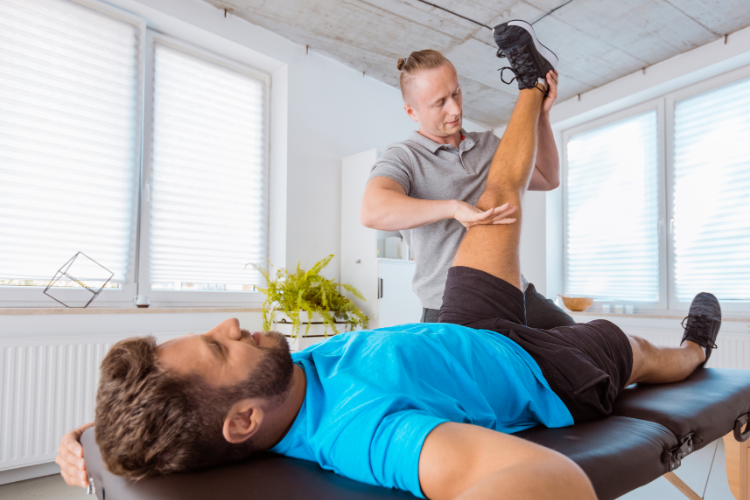Everyone knows that working out is good for you. It makes you stronger, improves your heart function and makes you a healthier person. However, as physical therapists, we see many people receive injuries from working out.
One of the ways to prevent injuries is through warming up before exercise. Just like you wouldn't drive a car super fast right away in cold weather, your muscles and joints need time to get ready for heavy activity.
To help you master the art of a proper warm-up, we are offering some essential tips for every runner, athlete or anyone else looking to get the most out of their exercise routine and prevent injury.
>> Book Your PT Appointment with Park North Physical Therapy to Perform Better In Your Sport
The Importance of Warming Up
Warming up before any physical activity is crucial for a variety of reasons. Firstly, cold muscles tend to be less elastic, making them more prone to strains and sprains. By gradually increasing muscle temperature through a proper warm-up, flexibility is enhanced, thus reducing the risk of injuries. Additionally, warming up helps boost performance by increasing blood flow to the muscles. This ensures they are supplied with enough oxygen and nutrients, priming them for optimal activity. Beyond the physical benefits, warm-ups also play a pivotal role mentally. They provide a crucial transition period, allowing individuals to set their goals, focus, and mentally prepare for the task ahead, be it a soccer match or the challenging NYC marathon.
Components of a Proper Warm-Up
- Cardio Warm-Up: Begin with 5-10 minutes of light aerobic activity to get your heart rate up. This can be brisk walking, light jogging, cycling on a stationary bike or even jumping jacks.
- Dynamic Stretching: Unlike static stretching, which involves holding a position for a length of time, dynamic stretching is all about movement. Examples include leg swings, walking lunges or arm circles. This prepares your muscles and joints for the range of motion they'll be undergoing during the main workout.
- Sport-Specific Movements: If you’re preparing for a particular activity or sport, integrate movements related to that. For instance, if you're about to play tennis, mimic some forehand and backhand strokes.
- Activation Exercises: These target and activate specific muscle groups that will be heavily utilized in your workout. For instance, if you're about to do barbell squats, some bodyweight squats or glute bridges can help activate your lower body muscles.
Park North’s Recommended Warm-Up for Runners
1. Easy Cardio: Begin with 2 minutes of light cardio exercises such as butt kicks, jumping jacks, or high knees. This phase is mainly to increase your blood circulation and to gently prime your muscles for more strenuous activities.
2. Dynamic Stretching: Engaging in stretches that incorporate movement not only helps improve your range of motion but also ensures that your muscles are adequately prepped for the run ahead.
- Leg Swings: Grab onto a steady object for support. Swing one leg forward and backward, then from side-to-side. Perform 10-15 swings for each leg in both directions.
- Walking Lunges: Advance a step and gently descend your body into a lunge position. Use your front foot to propel yourself forward and simultaneously bring your back foot forward for the subsequent step. Complete 10-15 lunges for each leg.
3. Stride Outs: Upon concluding your dynamic stretches, execute 4-6 stride outs. These short running bursts, spanning 60-100 meters, start at a moderate jogging pace, and gradually accelerate to about 85% of your peak speed before decelerating. Stride outs are excellent for bridging the gap between your warm-up and the core workout.
4. Focused Static Stretches: For those with specific tight spots, a few static stretches can be introduced, holding each stretch for a duration of 15-30 seconds. Possible stretches include:
- ITB Stretches: Given the susceptibility of especially female runners to ITB issues owing to the angle of their hips, ITB stretches are pivotal. This band can become strained when muscles fatigue, so it's important to keep it loose.
- Hip Flexor Stretches: Prolonged running can often lead to tightness in the hip flexors, making this stretch crucial.
- Thoracic Spine Rotation: Enhancing thoracic mobility can aid in improving posture and running form.
5. Stay Hydrated: Consume an adequate amount of water before embarking on your primary run. This ensures that you initiate your run in a well-hydrated state, optimizing performance and reducing the risk of dehydration.
Things to Keep in Mind During Your Warm-Up
Duration Matters
The length and intensity of your warm-up should match your main workout. For example, if you're planning a 30-minute light jog, a 5-minute easy warm-up should suffice. However, if you're preparing for an hour-long, high-intensity interval training (HIIT) session, aim for at least a 10-15 minute dynamic warm-up to properly prep your muscles and cardiovascular system.
Stay Hydrated
Drinking water before, during, and after your warm-up helps your muscles work properly and keeps cramps at bay. On hot and humid days, you might sweat more than usual even during your warm-up. Make sure to sip water every few minutes. If you're going into a prolonged workout session, consider an electrolyte drink post-warm-up to maintain essential mineral balance.
Listen to Your Body
Your warm-up is meant to prepare you, not hurt you. Always be alert to how your body responds. Let’s say, for example, you're doing leg swings as part of your dynamic stretching and you feel a sharp pain or pull in your hamstring. Instead of pushing through, stop and gently stretch the area. If the pain persists, it might be best to adjust your main workout or rest altogether.
Improve Your Athletic Performance with Park North Physical Therapy
Every individual is unique, and so should be their warm-up routine. What works for one might not work for another. At Park North Physical Therapy, our team of seasoned therapists can craft a warm-up and recovery regimen tailored specifically to your needs using a combination of hands-on therapy and innovative technology, ensuring you get the most out of your workouts and reduce the risk of injuries.
Ready to level up your performance? Harness the power of a personalized approach. Book an appointment with our therapists at Park North in Harlem or Morningside Heights, and let us guide you on your journey to optimal physical performance and health. Your body deserves the best, and we’re here to deliver just that.







